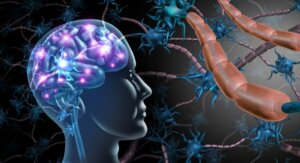Multiple Sclerosis: Symptoms, Causes and Treatment

Listed as a chronic disease, multiple sclerosis (MS) is a condition that affects the central nervous system. It’s characterized by progressive damage to myelin, a layer that covers the neurons.
When myelin is damaged in several areas, it leaves a mark or scar known as sclerosis. It’s also an autoimmune disease; this means that the immune system behaves as it does with a virus or bacteria, but, in this case, attacking healthy tissue.
Symptoms can range from mild to severe, and includes muscle pain and weakness. In this article, we’ll show you everything related to multiple sclerosis, and its symptoms, types, causes, diagnosis, and treatment.
Symptoms of multiple sclerosis
The symptoms related to this disease can vary from person to person. They can get worse in just a matter of days, or it could be months or years. It’s also possible that they won’t get worse at all. Among the most common signs, we can find the following:
Tiredness

According to a report by the National Multiple Sclerosis Society, 80% of the people who have this disease experience fatigue. This makes it extremely difficult to carry out their daily tasks, as they constantly experience tiredness.
Difficulty walking
People with multiple sclerosis often have problems with balance, numbness in the limbs, spasms, and muscle weakness, making it difficult for them to walk normally.
Vision problems
This disease can damage one or both eyes; in fact, this is considered to be one of the first signs. In some cases, the vision problem disappears over time, but, in others, it can get worse.
Among the most common vision conditions, we can highlight diplopia, nystagmus, optic neuritis, and blindness.
Speech problems
By affecting the brain, speech function can be compromised. Dysarthria is the term used to describe this problem, and some of its symptoms may be speaking slowly, having long pauses between words, and a strained voice.
Other symptoms
- Difficulty eating, especially swallowing and chewing
- Shaking
- Persistent pain
- Emotional ups and downs and depression
- Memory and learning problems
- Sleep disturbances
- Problems with bladder control or constipation
- Sexual dysfunction
- Numbness
- Dizziness
Causes and risk factors
At present, experts don’t know what exactly causes multiple sclerosis or why some people develop it and others don’t. All we have are some indications of what could cause it, but there’s no conclusive evidence. However, the following risk factors can be found:
- Being between 20 and 40 years old.
- Being a woman, as this disease usually affects females more than males.
- Having a family history; even though experts don’t consider it to be hereditary, there’s a small possibility that you’ll develop it if any member of the family suffers from it.
- Being a smoker.
- Having been exposed to the Epstein-Barr virus (EBV) or having suffered from mononucleosis, although there’s still more research needed to support this theory.
- Being deficient in vitamin D and B12.
Diagnosis
Your doctor may ask for some neurological tests and ask you some routine questions. If they suspect that you’re experiencing MS, then they’ll ask you to do the following tests to rule it out:
- Magnetic resonance imaging: This is to assess the state of the brain, to see if there are active or inactive lesions in the brain and the spinal cord.
- Lumbar puncture: This will rule out any abnormalities in the cerebrospinal fluid or any infectious disease.
- Optical coherence tomography: This test is to find out if there’s a thinning around the optic nerve.
- Visual evoked potentials test: This test studies the electrical activity of the brain.
- Blood test: This will allow you to analyze the values and rule out other symptoms of the disease.
Types of multiple sclerosis
As of today, four types of MS have been identified:
Clinically isolated syndrome (CIS)
This is characterized by having a single episode that lasts around 24 hours. Even if a person experiences this first episode, this isn’t enough for a specialist to diagnose CIS. To confirm the diagnosis, the patient must experience a similar episode at a later date.
Recurrent-remitting multiple sclerosis (RRMS)
This is the most common type of multiple sclerosis, according to a study, and it represents 85% of all cases of this pathology. RRMS consists of relapses of spontaneous remission, with new, moderate, or more severe symptoms. That is, there may be a partial or total disappearance of the symptoms.
Primary progressive MS (PPMS)
In this type, the symptoms tend to get progressively worse. However, it’s also true that some people may experience periods of stability.
Secondary progressive MS (PSMS)
This occurs when a person with RRMS goes into a progressive state. Relapses are notable and disability may develop, or they may experience a gradual worsening of the disease.
In the same way, relapses are more frequent, and they can overlap one another; the periods of remission also become irregular.
Treatment for multiple sclerosis

Unfortunately, there’s still no cure for multiple sclerosis. However, there are some treatments that can help reduce symptoms or even delay the disease.
Medications to slow progression
There are special medications that can slow down the progression of the disease and the intervals between relapses. Some of these injectable medications for RRMS include the following:
- Rebif
- Plegridy
- Extavia
- Avonex
- Betaseron
Among the oral drugs we find:
- Fingolimod (Gilenya)
- Diroximel fumarate (Vumerity)
- Dimethyl fumarate (Tecfidera)
- Siponimod (Mayzent)
- Cladribine (Mavenclad)
- Teriflunomide (Aubagio)
Medications for intravenous infusion to treat RRMS include the following:
- Mitoxantrone (Novantrone)
- Alemtuzumab (Lemtrada)
- Ocrelizumab (Ocrevus)
- Natalizumab (Tysabri)
Keep in mind that not all of these treatments are suitable for everyone with MS. You should go to a specialist and they’ll prescribe you the most appropriate medication and dosage. Each drug has its risks, and so you should never take them without the supervision of your doctor.
Treatment and alternative therapies for multiple sclerosis
According to a study by the Journal of Neurology, Neurosurgery and Psychiatry, cannabis may help alleviate some MS symptoms such as pain, insomnia, and muscle stiffness. However, more research is still needed to confirm such claims.
Among other treatments that people who suffer from multiple sclerosis usually receive are acupuncture, physical therapy, cognitive rehabilitation, massage, and occupational, speech, and stem cell therapy.
Listed as a chronic disease, multiple sclerosis (MS) is a condition that affects the central nervous system. It’s characterized by progressive damage to myelin, a layer that covers the neurons.
When myelin is damaged in several areas, it leaves a mark or scar known as sclerosis. It’s also an autoimmune disease; this means that the immune system behaves as it does with a virus or bacteria, but, in this case, attacking healthy tissue.
Symptoms can range from mild to severe, and includes muscle pain and weakness. In this article, we’ll show you everything related to multiple sclerosis, and its symptoms, types, causes, diagnosis, and treatment.
Symptoms of multiple sclerosis
The symptoms related to this disease can vary from person to person. They can get worse in just a matter of days, or it could be months or years. It’s also possible that they won’t get worse at all. Among the most common signs, we can find the following:
Tiredness

According to a report by the National Multiple Sclerosis Society, 80% of the people who have this disease experience fatigue. This makes it extremely difficult to carry out their daily tasks, as they constantly experience tiredness.
Difficulty walking
People with multiple sclerosis often have problems with balance, numbness in the limbs, spasms, and muscle weakness, making it difficult for them to walk normally.
Vision problems
This disease can damage one or both eyes; in fact, this is considered to be one of the first signs. In some cases, the vision problem disappears over time, but, in others, it can get worse.
Among the most common vision conditions, we can highlight diplopia, nystagmus, optic neuritis, and blindness.
Speech problems
By affecting the brain, speech function can be compromised. Dysarthria is the term used to describe this problem, and some of its symptoms may be speaking slowly, having long pauses between words, and a strained voice.
Other symptoms
- Difficulty eating, especially swallowing and chewing
- Shaking
- Persistent pain
- Emotional ups and downs and depression
- Memory and learning problems
- Sleep disturbances
- Problems with bladder control or constipation
- Sexual dysfunction
- Numbness
- Dizziness
Causes and risk factors
At present, experts don’t know what exactly causes multiple sclerosis or why some people develop it and others don’t. All we have are some indications of what could cause it, but there’s no conclusive evidence. However, the following risk factors can be found:
- Being between 20 and 40 years old.
- Being a woman, as this disease usually affects females more than males.
- Having a family history; even though experts don’t consider it to be hereditary, there’s a small possibility that you’ll develop it if any member of the family suffers from it.
- Being a smoker.
- Having been exposed to the Epstein-Barr virus (EBV) or having suffered from mononucleosis, although there’s still more research needed to support this theory.
- Being deficient in vitamin D and B12.
Diagnosis
Your doctor may ask for some neurological tests and ask you some routine questions. If they suspect that you’re experiencing MS, then they’ll ask you to do the following tests to rule it out:
- Magnetic resonance imaging: This is to assess the state of the brain, to see if there are active or inactive lesions in the brain and the spinal cord.
- Lumbar puncture: This will rule out any abnormalities in the cerebrospinal fluid or any infectious disease.
- Optical coherence tomography: This test is to find out if there’s a thinning around the optic nerve.
- Visual evoked potentials test: This test studies the electrical activity of the brain.
- Blood test: This will allow you to analyze the values and rule out other symptoms of the disease.
Types of multiple sclerosis
As of today, four types of MS have been identified:
Clinically isolated syndrome (CIS)
This is characterized by having a single episode that lasts around 24 hours. Even if a person experiences this first episode, this isn’t enough for a specialist to diagnose CIS. To confirm the diagnosis, the patient must experience a similar episode at a later date.
Recurrent-remitting multiple sclerosis (RRMS)
This is the most common type of multiple sclerosis, according to a study, and it represents 85% of all cases of this pathology. RRMS consists of relapses of spontaneous remission, with new, moderate, or more severe symptoms. That is, there may be a partial or total disappearance of the symptoms.
Primary progressive MS (PPMS)
In this type, the symptoms tend to get progressively worse. However, it’s also true that some people may experience periods of stability.
Secondary progressive MS (PSMS)
This occurs when a person with RRMS goes into a progressive state. Relapses are notable and disability may develop, or they may experience a gradual worsening of the disease.
In the same way, relapses are more frequent, and they can overlap one another; the periods of remission also become irregular.
Treatment for multiple sclerosis

Unfortunately, there’s still no cure for multiple sclerosis. However, there are some treatments that can help reduce symptoms or even delay the disease.
Medications to slow progression
There are special medications that can slow down the progression of the disease and the intervals between relapses. Some of these injectable medications for RRMS include the following:
- Rebif
- Plegridy
- Extavia
- Avonex
- Betaseron
Among the oral drugs we find:
- Fingolimod (Gilenya)
- Diroximel fumarate (Vumerity)
- Dimethyl fumarate (Tecfidera)
- Siponimod (Mayzent)
- Cladribine (Mavenclad)
- Teriflunomide (Aubagio)
Medications for intravenous infusion to treat RRMS include the following:
- Mitoxantrone (Novantrone)
- Alemtuzumab (Lemtrada)
- Ocrelizumab (Ocrevus)
- Natalizumab (Tysabri)
Keep in mind that not all of these treatments are suitable for everyone with MS. You should go to a specialist and they’ll prescribe you the most appropriate medication and dosage. Each drug has its risks, and so you should never take them without the supervision of your doctor.
Treatment and alternative therapies for multiple sclerosis
According to a study by the Journal of Neurology, Neurosurgery and Psychiatry, cannabis may help alleviate some MS symptoms such as pain, insomnia, and muscle stiffness. However, more research is still needed to confirm such claims.
Among other treatments that people who suffer from multiple sclerosis usually receive are acupuncture, physical therapy, cognitive rehabilitation, massage, and occupational, speech, and stem cell therapy.
- National Multiple Sclerosis Society. MS Symptoms. Available from: https://www.nationalmssociety.org/Symptoms-Diagnosis/MS-Symptoms#section-0
- Fundación GAEM [Published 2018 Mar 08]. Mujer y Esclerosis Múltiple: el perfil del 70% de personas con EM es mujer entre 20 y 40 años. Available from: https://fundaciongaem.org/mujer-y-esclerosis-multiple/
- Hoppenbrouwers, I. A., & Hintzen, R. Q. (2011). Genetics of multiple sclerosis. Biochimica et biophysica acta, 1812(2), 194–201. https://doi.org/10.1016/j.bbadis.2010.09.017
- Ghasemi, N., Razavi, S., & Nikzad, E. (2017). Multiple Sclerosis: Pathogenesis, Symptoms, Diagnoses and Cell-Based Therapy. Cell journal, 19(1), 1–10. https://doi.org/10.22074/cellj.2016.4867
- National Multiple Sclerosis Society.Relapsing-remitting MS (RRMS). Available from: https://www.nationalmssociety.org/What-is-MS/Types-of-MS/Relapsing-remitting-MS
- Zajicek, J. P., Hobart, J. C., Slade, A., Barnes, D., Mattison, P. G., & MUSEC Research Group (2012). Multiple sclerosis and extract of cannabis: results of the MUSEC trial. Journal of neurology, neurosurgery, and psychiatry, 83(11), 1125–1132. https://doi.org/10.1136/jnnp-2012-302468
Este texto se ofrece únicamente con propósitos informativos y no reemplaza la consulta con un profesional. Ante dudas, consulta a tu especialista.







